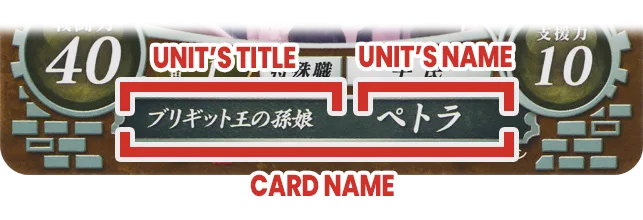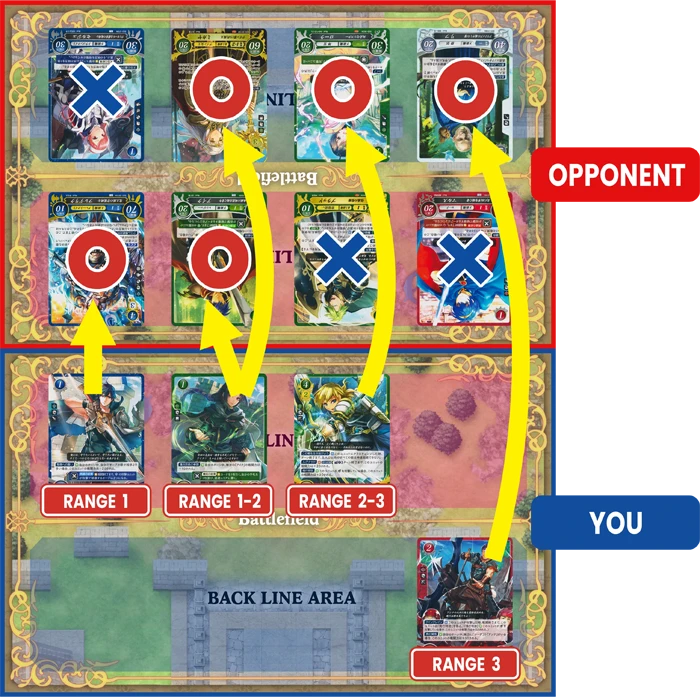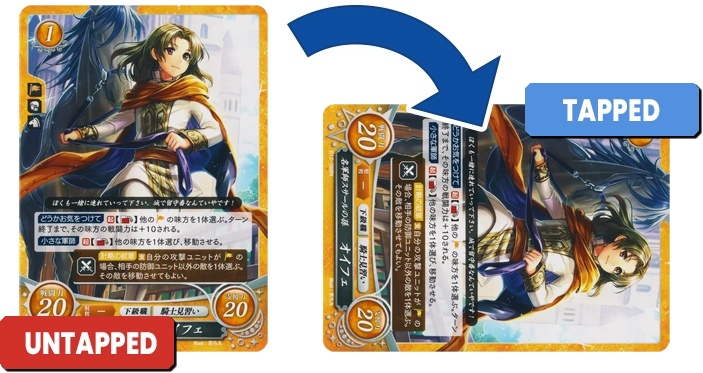Glossary
Affinity
Affinities are divided into three categories: Gender, Weapons and Types.
Allies
Represents your units on the Battlefield.
Attacking unit
Unit that initiates a battle.
Battlefield
The Front Line Area and the Back Line Area constitute the “Battlefield”. This is where units are deployed.
Bond
Card located in the Bond Area. Bonds are used to deploy units, level up/class changes or as skill costs.
Card Name
The Unit Title and Unit Name on a card form the Card Name. One of the three rules of deck building requires respecting the number of copies with the same Card Name.

Class Change
One of the actions possible during the Deployment Phase. The Class Change is performed by placing a unit from your hand on top of a unit present on the Battlefield while paying the indicated Class Change Cost in Bonds. The unit in your hand and the unit on the field must have the same Unit Name.
Following a Class Change, draw a card from the top of the deck as a bonus.
Class Change Cost
Bond cost required for a Class Change.
Critical Hit
Performing a Critical Hit doubles the attacking unit's attack power, including any support values and bonus skills.
Deck
Set of cards for playing Fire Emblem Cipher. Also refers to the place on the board that serves as the draw pile.
Defending unit
Unit targeted by an attack.
Deployment
Action of placing a unit on the Battlefield.
Deployment Cost
Bond cost required to deploy the unit on the Battlefield.
Evasion
Evasion immediately nullifies a unit's attack (unless otherwise indicated by a skill) and ends the battle.
Flip
Action of flipping [ ] a Bond to pay the cost of activating a skill.

Forced March
If the loss or movement of a unit leaves the defending player without a single unit on his Front Line Area, a “Forced March” occurs to fill the vacant space. The defender then immediately moves all his Back Line Area units to the Front Line Area.
If the attacker has no units on the Front Line Area at the start of the opposing player's turn, all his Back Line Area units immediately move to the Front Line Area.
Growth
Action of “stacking“ a card with the same unit name under a unit using skills. A unit that has performed a Growth is considered to have levelled up, and can therefore use its Class Change skills.
Keyword Skill
A Keyword precedes the skill name. Has specific prerequisites for use, unlike a normal skill.
Level Up
Action of placing a card from your hand on a unit present on the Battlefield, while paying the Deployment Cost in Bond. The unit in your hand and the unit on the field must have the same unit name. One of the actions possible during the Deployment Phase.
Main Character
Unit with which each player starts the game. It is chosen with a Deployment Cost of 1 before the start of the game. The Main Character has five orbs, similar to life points. When you defeat the opposing Main Character, one orb is destroyed. If you succeed in defeating your opponent when he has no more orbs, you are declared the winner.
Movement
Movement of a unit between the two areas of the Battlefield (from the Front Line Area to the Back Line Area or vice versa).
Orb
Can be compared to the life points of the Main Unit. Five orbs are placed before the start of the game, and each time the Main Unit is defeated, an orb is removed. If all orbs are destroyed and the Main Unit is defeated again, the game ends.
Range
Depending on the unit's weapon, the range can be 1, 2, 3, or several at once. For example, a range of 1-3 means that the attack range can be 1, 2 or 3.

Skill
Special abilities that units have at their disposal. They fall into two categories: normal skills and support skills.
Skill types
Seven types of skills exist, each with its own restrictions and activation conditions.
- 起 / ACT : Activate
Skill to be activated during your Action Phase. You can activate this type of skill at any point, except when a unit is attacking. - 自 / AUTO : Trigger
Skill triggered automatically when the condition is fulfilled (response to an action, a specific condition, etc.). Can be activated as many times as the condition is fulfilled. - 常 / CONT : Continuous
Skill always active as long as the unit is on the Battlefield (unless otherwise specified) and as long as the condition is fulfilled. - 絆 / BOND : Bond
Skill can only be activated when the card is in the Bond Area and face-up. - 礼 / HAND : Hand
Skill that can only be activated when the card is in your hand. - 支 / SUPP : Support
Support skill activated during a combat when the card is in the Support Area. - 特 / SPEC : Special
Skill that does not belong to any of the above-mentioned types.
Support
Card in Support Area. During a battle, draw a card from the top of the deck to place it in the Support Area, and thus determine the success or failure of support to the unit in combat.
- Support is considered successful if the unit names are different.
- Support is unsuccessful if both cards have the same unit name (e.g. Marth cannot support Marth), in which case the supporting unit is immediately sent to the Retreat Area.
Support unit
Card on the Support Area.
Tap
Action of tapping [ ] a unit 90 degrees clockwise. To mark an action performed by a unit on the Battlefield.

Unit
Card on the Battlefield.
Untap
Action of switching a tapped card from horizontal to vertical.